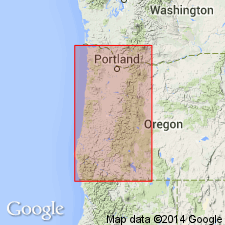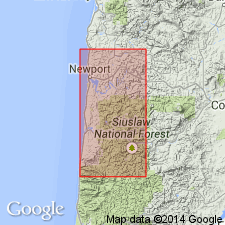
- Usage in publication:
-
- Moody shale member
- Modifications:
-
- Original reference
- Dominant lithology:
-
- Shale
- AAPG geologic province:
-
- Western Columbia basin
Summary:
Pg. 455, 456, 457, 459. Moody shale member of Toledo formation. Concretionary shale, about 1,200 feet thick, overlying Burpee formation and forming lower member of Toledo formation. Fossils rare, but formation is assigned to lower Oligocene.
Type locality: railroad cuts at Moody Station, on Southern Pacific RR, between Yaquina and Toledo, in Lincoln Co., northwestern OR.
Source: US geologic names lexicon (USGS Bull. 896, p. 1415).

- Usage in publication:
-
- Moody shale member
- Modifications:
-
- Overview
- AAPG geologic province:
-
- Western Columbia basin
Summary:
Pg. 22-31. Moody shale member lies near base of Toledo formation. [Age is Oligocene.]
Source: US geologic names lexicon (USGS Bull. 896, p. 1415).

- Usage in publication:
-
- Moody shale member*
- Modifications:
-
- Redescribed
- Age modified
- Dominant lithology:
-
- Mudstone
- Sandstone
- AAPG geologic province:
-
- Western Columbia basin
Summary:
Moody shale member of Toledo formation. Dark to black hard tuffaceous mudstones, commonly intricately fractured, with occasional discontinuous, irregular, hard cemented limy bands a few inches thick; interbedded fine- and medium-grained sandstones containing glauconite and coarse pumiceous material occur at numerous horizons; carbonaceous material and plant fragments abundant in sandstones near base. Thickness 1,500 to 1,800 feet. Along Eckman Creek and south of Green Mountain, member becomes markedly tuffaceous and interfingers with volcanic rocks of the Toledo to the south. Underlies an unnamed sandy member 1,000 to 1,200 feet thick; overlies Burpee formation. Age is late Eocene. (Moody shale member of Toledo formation adopted by the USGS.)
Type locality: at Moody School, north bank of Yaquina River in sec. 30, T. 11 S., R. 10 W., Lincoln Co., northwestern OR.
Source: US geologic names lexicon (USGS Bull. 1200, p. 2576).

- Usage in publication:
-
- Moody Shale Member†
- Modifications:
-
- Abandoned
- AAPG geologic province:
-
- Western Columbia basin
Summary:
†Moody Shale Member of †Toledo Formation abandoned (both names); its rocks now
assigned to (ascending) Yamhill and Nestucca Formations (now geographically ex-
tended into Oregon Coast Range, northwestern Oregon).
Source: Changes in stratigraphic nomenclature, 1975 (USGS Bull. 1422-A, p. A26-A27).
For more information, please contact Nancy Stamm, Geologic Names Committee Secretary.
Asterisk (*) indicates published by U.S. Geological Survey authors.
"No current usage" (†) implies that a name has been abandoned or has fallen into disuse. Former usage and, if known, replacement name given in parentheses ( ).
Slash (/) indicates name conflicts with nomenclatural guidelines (CSN, 1933; ACSN, 1961, 1970; NACSN, 1983, 2005, 2021). May be explained within brackets ([ ]).

